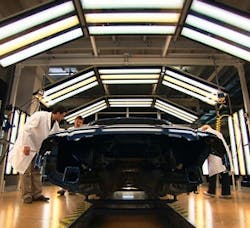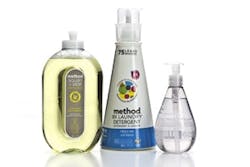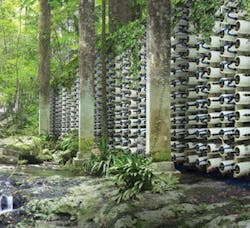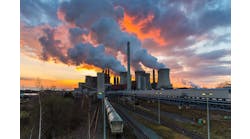Operating companies such as BASF, Eastman Chemical, Amcor and Dow Chemical are benefiting from using sustainability metrics to meet the challenge of improving products and processes.
“Though a number of different measurement and valuation methods exist for sustainability, most of them are focused exclusively on ecological aspects, i.e., impact on climate, forest decline or water. However, methods developed on that basis reflect only a small part of what sustainability is all about: balancing environment, society and economics. The aim of BASF’s analysis methods is therefore to quantify corresponding aspects,” says a spokesman for the Ludwigshafen, Germany-based company.
[callToAction ]
This was the driving force behind BASF’s new sustainable solution steering method that is used to systematically review and evaluate the sustainability aspects of its product portfolio.
Between 2011 and the end of 2014, the company used the method to conduct sustainability assessments and evaluations on 98.3% of its entire portfolio of more than 60,000 specific product applications — which together account for €66.3 billion ($71.8 billion) in annual sales.
The product applications analyzed were put into one of four categories: accelerator, performer, transitioner or challenged. Accelerators contribute particularly to sustainability in the value chain. Performers meet all the market’s standard sustainability requirements. Transitioners are products for which specific sustainability targets have been established, and plans of action have been set up and are actively underway. Challenged products don’t sufficiently fulfill sustainability criteria and, thus, require improvement, which can include research projects, reformulations or even replacement by an alternative product.
Figure 1. Eliminating the need for a primer and a baking step reduces energy consumption as well as harmful emissions. Source: BASF.
Of the analyzed products, 23% (by sales) turned out to be accelerators, around 74.1% fell into the performer category, approximately 2.6% were classified as transitioners, and 0.3% were judged challenged.
“We aim to increase the number of accelerator solutions in the long term in order to further improve the sustainability contribution made by BASF and its customers. This is why our product portfolio is constantly being reviewed,” notes the spokesman.
The company now offers a broad range of accelerators for the automotive industry, including lightweight plastic materials to minimize the weight of cars, improved catalysts to decrease harmful exhaust emissions, and integrated processes to speed the coating process by eliminating the primer and a baking step, thus providing clear savings in energy consumption as well as lower greenhouse gas (GHG) and volatile organic compound (VOC) emissions (Figure 1). In the packaging sector, accelerators include polyamide films for flexible packaging, water-based resins for flexible printing, and bio-based or compostable materials.
The company also uses a range of other techniques to assess sustainability. One, eco-efficiency analysis, compares the lifecycles of products or manufacturing processes from cradle to grave and includes, for example, the environmental impact of products used by BASF, as well as starting materials manufactured by others. The evaluation also takes into account the consumption behavior of end-users, as well as various recycling and disposal options. Seven factors are considered: water consumption, abiotic resource depletion, cumulative energy consumption, land use, emissions, toxicity potential, and occupational illnesses and accidents.
BASF performed such an analysis on indigo, the dye that makes jeans blue. Here, the company compared its existing dye with a newly developed product to answer questions such as how much product is needed to dye 1,000 pairs of jeans, how much energy is necessary, what the emissions and waste products are, and how long the fabric holds its color. Based on the results, BASF was able to suggest the most eco-efficient solution to textile customers.
Another tool is socio-eco-efficiency (SEEBalance) analysis. This allows assessing not only environmental consequences and costs but also the societal impacts of products and processes. The aim is to quantify performance of all three pillars of sustainability with one integrated tool to direct — and measure — sustainable development in companies. SEEBalance is finding a major use for socio-economic analysis for REACH authorization, says the company.
Data from these and other tools are helping BASF establish the overall product carbon footprint, i.e., the sum of the GHG emissions generated by a product over its entire lifecycle.
Collaboration Benefits
At Eastman Chemical, Kingsport, Tenn., sustainability serves as a lens for how the company does business. “It encompasses the triple bottom line — people, planet and prosperity (or economic growth, environmental stewardship and societal responsibility). We define corporate sustainability goals to support each pillar of sustainability, and we report progress on those goals annually,” notes Anne Kilgore, director of sustainability.
One method the company uses to sharpen its understanding of sustainability challenges and opportunities for the industry and for the value chains it’s part of is by participating in external collaborations and working groups such as the World Business Council for Sustainable Development (WBCSD), Geneva, Switzerland.
“We recognize that cross-value-chain collaborations on business-led solutions like those in the WBCSD improve the likelihood for positive impact and meaningful progress on some of the world’s toughest problems that individual efforts cannot accomplish alone,” she adds.
One effect of this collaboration is an effort to complete lifecycle assessments (LCAs) on all new product family launches. Through the WBCSD’s Reaching Full Potential sector project, the company participated in the development of and use the WBCSD generated guide “Life Cycle Metrics for Chemical Products” (see: "Group Issues Guide to Sustainability Metrics,”) to perform LCAs that align with chemical industry standards.
Figure 2. Analysis tool helps in selecting most-sustainable container, e.g., 100% recycled PET (left and right) or 50/50 blend of recycled and virgin HDPE (center). Source: Amcor.
“LCA data allows us to quantify and characterize aspects of environmental sustainability for our products. LCA studies identify areas of concern — or hot spots — in a product lifecycle and inform actions taken to prevent, reduce or mitigate impacts on the environment while avoiding unintended consequences. Using the guide improves credibility, consistency and comparability of results of LCAs on chemical products, allowing the chemical industry to move forward together on sustainability initiatives,” she explains.
One success Kilgore cites for Eastman’s LCA team involves a Chinese government mandate for use of waterborne coatings on automobiles: “Through the LCA results provided by Eastman, we proved that high-solid, solvent-borne coatings were a better alternative in most cases, producing lower GHG emissions while achieving VOC emission performance equivalent to waterborne options.”
A second example involves an LCA performed on an Eastman architectural-window-films brand, IQue, which followed guidance outlined in “Addressing the Avoided Emissions Challenge,” which also was developed by the WBCSD’s Reaching Full Potential sector project. That LCA demonstrated the window films, which are applied to existing windows to improve interior living space comfort and save energy by blocking entrance of UV and IR radiation, become carbon- and energy-neutral after less than one year of use. Essentially, this means the window films save more energy and prevent more GHG emissions than were expended during their manufacture (cradle-to-gate).
“Eastman has had a very positive experience within the WBCSD’s Reaching Full Potential sector and across our industry, including the International Chemical Council Association (ICCA), where the publication of the avoided emissions guidance sparked the formation of a Carbon Life Cycle Assessment (ICCA cLCA) task force that we have joined. This industry group is evaluating avoided emissions case studies to encourage widespread adoption and alignment of the ‘Addressing the Avoided Emissions Challenge’ guidelines within the chemical industry,” concludes Kilgore.
Significant Savings
Amcor, Ann Arbor, Mich., which has more than 27,000 employees working at 180 sites in 43 countries and is a global leader in the supply of rigid and flexible packaging products, uses as one of its key metrics LCA software known as the advanced sustainability stewardship evaluation tool (ASSET). Development of the software was started in 2006 by Alcan. When Amcor acquired parts of that company’s packaging business in 2009, development continued.
Today, Amcor’s product engineering and design department uses ASSET for comparative product design work (Figure 2). It allows evaluating a wide range of factors over the entire run of a packaging material, including non-renewable primary energy use, GHG potential (both fossil and biogenic balance), water consumption, ozone depletion potential, and a ReCiPe score (an aggregated environmental impact score akin to a balanced scorecard view toward environmental depletion potential that uses a variety of weighted metrics).
“Since 2009, we have been updating ASSET frequently with new data sets in order to get the most accurate library of polymer and packaging material data possible. This includes input from third-party data suppliers such as the U.S. NREL life cycle inventory (LCI) database — which is pretty much the bible for LCI metrics,” explains global sustainability manager Charlie Schwarze.
ASSET now contains a history of every LCA assessment undertaken by AMCOR — over 4,200 — including 599 alone in the 2013/2014 financial year. The software also encompasses primary data on any material that can be used for packaging, including polymers, metal and glass, together with LCI information on some secondary materials such as corrugate, shrink wrap and labels. There’re some data on transportation, too, including shipping by rail, ocean freight and land transport, but overall it mainly concerns upstream cradle-to-gate impacts and end-of-life issues such as recycling.
“In the last three years, ASSET has helped our designers and engineers to reduce the amount of PET resin that we use in packaging manufacturing by 24 million pounds — equivalent to 57 million pounds of upstream carbon emissions. We have also reduced production costs,” notes Schwarze.
“Where we really can help both ourselves and our customers is in helping to understand where in the supply chain an impact is happening. This might be, for example, raw material manufacturing, our own production, or in looking at the end-of-life environmental impact of a material or combination of materials,” he adds.
An example he cites here is in the dairy industry, where one of the most important impacts on the supply chain comes when milk has to be put into containers. These often are made of a high-density polyolefin. In this situation, Amcor can bring the packaging impact data to the table and then combine them with a brand owner’s knowledge of its own process. “A dairy producer is in a much better position to understand the environmental impact of his or her own operations, and we are in the best position to provide the environmental impacts of the best packaging to that dairy operator,” explains Schwarze.
Figure 3. Units remove 40% more salt from seawater yet consume 30% less energy than industry-standard reverse osmosis elements. Source: Dow.
He also cites the example of a fruit juice company that wanted to lower the weight of its containers. Its plan to reduce the weight of the container to 59 g from 68 g would involve a large investment by both the company and by Amcor — for changing molds, and redesigning and retooling the filling line for a different shaped bottle neck: “Here we were able to understand completely the effect on GHG emissions that this would have and how it would help the customer to meet its sustainability goals. What we found was that by making this change, the company would cut GHG emissions by 14–15% (1,900 metric tons of carbon dioxide) during production of 50 million bottles. We also undertook several looks at recycled material contents in an effort to show the brand owner the environmental impact of using post-consumer recycled material.”
A Crucial Index
Meanwhile, as part of its 2015 sustainable chemistry goal, Dow Chemical, Midland, Mich., developed the sustainable chemistry index (SCI), a metric that has helped the company not only to assess the relative sustainability performance of its entire product portfolio but also to foster a culture of increased sustainability awareness.
Dow’s 2015 goal is to achieve 10% of its sales from products “highly advantaged” by sustainable chemistry. In 2013, the company reached the target, which represents a marked improvement from the baseline performance of 1.7% in 2007. Additionally, the Dow aggregate SCI score in 2013 hit an all-time high of 24.4 points, up from the 2007 baseline score of 20.4, notes Anne Wallin, director of sustainable chemistry. (An upcoming CP article by her will provide more details.)
The SCI scores take into account eight categories related to product sustainability, including renewable or recycled content, manufacturing efficiency, societal need benefit, and value chain risk, with a maximum score of 5 possible in each category.
Thanks to the SCI, the company has come up with a range of innovative products, including, for example, FilmTec Eco membrane modules (Figure 2). These filter out 40% more salt from seawater while consuming 30% less energy than industry-standard reverse osmosis elements.
The company also uses other tools and metrics, such as the Dow chemical sustainability footprint tool, which is applied in R&D work. “This covers economic, social and environmental factors and is available to all Dow customers,” explains Han Zhang, lead EHS & sustainability manager. “This method considers all stages of the value chain to show if the successful commercialization of the project should lead to a more-sustainable service delivered to an end user. Its use encourages lifecycle thinking, identification of gaps and opportunities for innovation, and provides insights into the sustainability of new product developments,” he adds.






